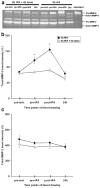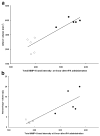Extension of the thrombolytic time window with minocycline in experimental stroke
- PMID: 18927459
- PMCID: PMC3705574
- DOI: 10.1161/STROKEAHA.108.514026
Extension of the thrombolytic time window with minocycline in experimental stroke
Abstract
Background and purpose: Thrombolysis with tPA is the only FDA-approved therapy for acute ischemic stroke. But its widespread application remains limited by narrow treatment time windows and the related risks of cerebral hemorrhage. In this study, we ask whether minocycline can prevent tPA-associated cerebral hemorrhage and extend the reperfusion window in an experimental stroke model in rats.
Methods: Spontaneously hypertensive rats were subjected to embolic focal ischemia using homologous clots and treated with: saline at 1 hour; early tPA at 1 hour, delayed tPA at 6 hours; minocycline at 4 hours; combined minocycline at 4 hours plus tPA at 6 hours. Infarct volumes and hemorrhagic transformation were quantified at 24 hours. Gelatin zymography was used to measure blood levels of circulating matrix metalloproteinase-9 (MMP-9).
Results: Early 1-hour thrombolysis restored perfusion and reduced infarction. Late 6-hour tPA did not decrease infarction but instead worsened hemorrhagic conversion. Combining minocycline with delayed 6-hour tPA decreased plasma MMP-9 levels, reduced infarction, and ameliorated brain hemorrhage. Blood levels of MMP-9 were also significantly correlated with volumes of infarction and hemorrhage.
Conclusions: Combination therapy with minocycline may extend tPA treatment time windows in ischemic stroke.
Figures




References
-
- NINDS rt-PA Stroke Study Group. Tissue plasminogen activator for acute ischemic stroke. N Engl J Med. 1995;333:1581–1587. - PubMed
-
- NINDS rt-PA Stroke Study Group. Intracerebral hemorrhage after intravenous t-pa therapy for ischemic stroke. Stroke. 1997;28:2109–2118. - PubMed
-
- Sumii T, Lo EH. Involvement of matrix metalloproteinase in thrombolysis-associated hemorrhagic transformation after embolic focal ischemia in rats. Stroke. 2002;33:831–836. - PubMed
-
- Montaner J, Molina CA, Monasterio J, Abilleira S, Arenillas JF, Ribó M, Quintana M, Alvarez-Sabín J. Matrix metalloproteinase-9 pretreatment level predicts intracranial hemorrhagic complications after thrombolysis in human stroke. Circulation. 2003;107:598–603. - PubMed
Publication types
MeSH terms
Substances
Grants and funding
LinkOut - more resources
Full Text Sources
Other Literature Sources
Miscellaneous

